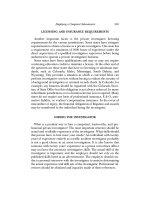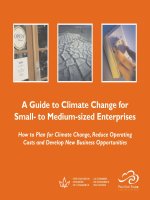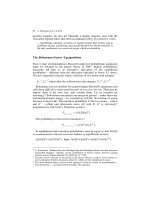A Guide to Climate Change for Small- to Medium-sized Enterprises phần 4 pps
Bạn đang xem bản rút gọn của tài liệu. Xem và tải ngay bản đầy đủ của tài liệu tại đây (254.61 KB, 11 trang )
A Guide to Climate Change for SMEs 27
conditioning energy use is available from the Natural
Resources Canada Office of Energy Efficiency (http://
oee.nrcan.gc.ca/english/index.cfm).
Improving Transportation
The transportation sector is the largest single source of
greenhouse gas emissions in Canada. The way vehicles
are driven and maintained can reduce greenhouse gas
emissions, reduce fuel consumption and save money.
Minimizing unnecessary engine idling, maintaining
correct tire pressure and following other energy
efficient practices can reduce fuel consumption. Energy
can also be saved by using intermodal transport.
Switching to fuels that emit fewer greenhouse gases,
such as gasoline with ethanol content, biodiesel or
natural gas, may also help.
When shopping for a new vehicle, ask your dealer
about the city and highway fuel consumption ratings
and the estimated annual fuel cost for that particular
vehicle. Choosing the most fuel efficient vehicle for
your everyday needs can save money and reduce
greenhouse gas emissions that contribute to climate
change.
Vehicle manufacturers are introducing more hybrid
vehicles
14
and other environmentally advanced
technology vehicles. While these vehicles are more
expensive to purchase, they may offer significant
reductions in fuel consumption. To offset some of the
higher capital costs, some vehicle insurance companies
have announced reduced insurance rates for buyers of
hybrid vehicles, and some provinces have introduced
incentives, such as reducing or eliminating the
provincial sales tax on these vehicles.
Terra Nova Transport — Fuel
Savings from Improving Vehicle
Fuel Economy
Terra Nova Transport is a less-than-
truckload carrier operating out of
Petitcodiac, New Brunswick. It began in
1983 and currently operates a fleet of 19
tractor-trailers and two straight trucks.
Originally a livestock hauler, Terra Nova
Transport became a dry-vans-only operation
in 1995. With a terminal in Brampton,
Ontario, the company operates mainly in a
triangular service area, from the Maritimes
to the Eastern Seaboard of the United
States, to Ontario and back into the
Maritimes. It also does runs to California,
Florida and Texas in the US.
With the rapidly rising diesel fuel prices
experienced in the late 1990s, the company
needed to improve its fuel economy. Two
major steps were taken: First, the company
started keeping records of fuel economy by
vehicle. Second, it used the SmartDriver
program information from FleetSmart (an
Office of Energy Efficiency program that
offers free practical advice on energy
efficient vehicles and how businesses can
reduce fleet operating costs;
/>fleetsmart.cfm) to initiate a fuel economy
incentive program. With these initiatives,
the company substantially improved its fleet
fuel economy. Fuel economy has improved
by at least one mile per gallon, leading to a
savings of 180,000 litres of fuel per year, or
nearly $100,000 in fuel costs. Greenhouse
gas emission reductions are estimated at
about 470 tonnes per year.
27
42776-wrk.qxp 10/12/2006 12:55 PM Page 33
28 chapter four : Reducing the Rate of Climate Change
Reducing Air Leakage by Caulking and
Weather Stripping
Older buildings have usually been constructed
with less insulation than modern buildings. They
can also have poorly fitting windows and doors
that permit air leakage, thus increasing heating
demands in winter and cooling requirements in
summer.
A number of measures can improve a building’s
energy efficiency, including
• weatherstripping doors and windows
• using plastic secondary-door curtains inside
delivery doors and bays
• improving the energy efficiency of windows
with solar glazing or reflective film
• sealing leaks and cracks using foams, caulking
and weatherstripping
• improving the insulation in attic spaces,
basements and walls, where feasible.
Choosing Energy Efficient Equipment and
Processes
Energy efficient office equipment, appliances and
motors are readily available and can consume
substantially less energy than their older
counterparts. Look for ENERGY STAR rated
equipment, such as copiers, computers, faxes,
washers and dryers, stoves and compressors,
when replacing or buying new equipment.
A number of factors need to be considered when
selecting motors. A motor’s efficiency is a
measure of the energy it delivers compared to the
energy it uses. It is important to choose the right
size of motor for the particular application. If a
motor is oversized, its efficiency will be lower
than if it is correctly sized. Variable speed drives
and variable frequency drives regulate motor
speeds according to the amount of work
required. Reducing motor speed by 10 per cent
can cut power consumption by 27 per cent;
reducing speed by 20 per cent can cut
consumption by 49 per cent. Combined with
high efficiency motors, variable speed and
variable frequency drives reduce both energy
consumption and noise.
42776-wrk.qxp 10/12/2006 12:55 PM Page 34
A Guide to Climate Change for SMEs 2929
Timothy’s World Coffee —
Waste Reduction Saves Money
1070 Eglinton Ave. West, Toronto,
Ontario, 416-785-8600
At Timothy’s on Eglinton Avenue West
in Toronto, being a part of the
community is part of being in business.
Located on a busy neighbourhood
corner, the café works tirelessly to
provide a comfortable community
meeting place and central focus for the
Upper Village area. Addressing
environmental issues is also a strong
emphasis in the business — one that
saves money, increases customer
loyalty and enhances Timothy’s image
in the community. Customers who bring
in their own mug for coffee receive a
free upgrade to a larger size. Through
the City of Toronto’s Yellow Bag
Program, the coffee shop has managed
to divert 84 per cent of its waste, saving
more than $2,000 annually. The Yellow
Bag Program (www.toronto.ca/
yellowbag/) is a waste management
initiative that encourages Toronto’s
commercial customers to decrease
garbage while increasing recycling and
organics collection. Commercial
customers eligible for municipal
garbage collection place garbage in
special yellow bags for pick-up.
Source: Clean Air Foundation, Cool
Shops. www.coolshops.ca.
Reducing Waste
When less waste is produced, less energy is required to
collect, transport and dispose of the waste and less energy
is needed to produce more new materials. Here are just a
few actions you can take to reduce the amount of waste
you produce:
• Recycle used materials, such as computer equipment
and printer cartridges.
• Reduce your use of paper.
• Adopt nutrient management practices for livestock that
reduce greenhouse gas emissions from manure.
• Find customers for residue by-products from
manufacturing processes.
There are many more ways to reduce waste in a business.
If you haven’t already done so, incorporate separate bins
for the collection of different types of wastes, such as
plastics, paper products and organic products. Other
measures to reduce waste include minimizing the number
of paper copies of documents, ordering supplies in larger
sized containers, and reducing the number of small quantity
orders to reduce packaging and the number of deliveries.
42776-wrk.qxp 10/12/2006 12:55 PM Page 35
30 chapter four : Reducing the Rate of Climate Change30
Selecting/Designing Business Premises
Selecting the location and type of facility in which to run a
business is an important decision. Choosing an energy
efficient building will result in lower energy bills.
Choosing a location near public transit will allow
customers and employees to reach the business without
having to drive their cars. For manufacturing facilities,
selecting locations near transportation facilities may offer
energy savings. Renting space in a building that has
individual energy and water meters for tenants will allow
you to track and manage your own energy and water
consumption.
Selecting fuels that emit fewer greenhouse gases and using
renewable energy can also help:
• Where available, use natural gas because it produces
less greenhouse gas emissions than oil or coal.
• Participate in local utility “green energy” projects.
• Locate wind turbines on your properties to reduce
reliance on electricity generated from fossil fuels.
15
• Use solar power to heat buildings and water.
Metro Label — Industrial
Facility Design Reduces Energy
Use
Metro Label’s new Scarborough,
Ontario, manufacturing plant will be the
first Leadership in Energy and
Environmental Design (LEED) certified
industrial building in the Greater
Toronto Area. The 150-employee facility
that makes labels for wine bottles,
pharmaceuticals, cosmetics and other
goods will use a heat recovery system
to recycle energy from printing presses
and reuse it to heat the building. It has
skylights to improve natural light and
reduce artificial lighting requirements.
It provides showers and bike racks to
encourage employees to cycle to work
instead of driving. The plant is
estimated to reduce overall building
energy use by 22 per cent compared to
a building of similar size, and to reduce
printing process energy use by 38 per
cent compared to its current operation.
Source: Bruser, David. “Label this
factory ‘green’; Metro Label’s new
Scarborough plant is not only
environmentally friendly, it makes
sound business sense.”
Toronto Star
May 1, 2005: A21.
42776-wrk.qxp 10/12/2006 12:56 PM Page 36
A Guide to Climate Change for SMEs 31
Involving Employees
Last but not least, engaging the cooperation and
innovation of employees is essential to achieving
a successful energy efficiency program. Help
employees understand and appreciate how
individual actions can make a difference in
reducing energy costs and greenhouse gas
emissions. Provide examples of how things that
they can easily do will contribute to the effort. A
number of things can be done to engage the help
of employees:
• Make energy efficiency a topic at staff
meetings or during refreshment breaks.
• Encourage suggestions for creative energy
efficiency improvements.
• Help employees understand that saving
energy helps improve the viability of the
business, their job security and the
environment. Provide examples of how
employees can help. For example,
• share the results of energy savings with
them
• include news about energy efficiency in
newsletters and on bulletin boards.
Informing employees about energy efficiency and
greenhouse gas emissions can also have a further
benefit by motivating them to undertake energy
improvements in their homes. Further
information about how individual Canadians
can improve energy efficiency is available at
www.onelesstonne.ca.
Absorbing and Storing
Greenhouse Gases
In addition to reducing the use of fossil fuels
through improved energy efficiency, businesses
can help slow the rate and magnitude of climate
change by pursuing opportunities to absorb and
store greenhouse gases. Forests and agricultural
soils both absorb and release carbon dioxide
through natural processes of photosynthesis and
decomposition. When, on balance, they absorb
more carbon dioxide than they release, they
become net carbon sinks. For example, as they
grow, trees and other plants “breathe in” and
store carbon dioxide from the atmosphere. A
single tree can absorb many tonnes of carbon
dioxide during its lifetime. Property owners can
help improve energy efficiency by planting
deciduous trees near the south- and east-facing
sides of buildings. These trees will help shade the
buildings and absorb carbon dioxide.
The BIOCAP Canada Foundation (www.biocap.ca),
a national not-for-profit research foundation, is
advancing our understanding of the role of
natural resources in mitigating climate change.
This knowledge has useful applications:
• In addition to reducing greenhouse gas
emissions by adopting climate-friendly
practices that improve nutrients and livestock
management, farmers can take action on
climate change by planting more trees around
farms to absorb carbon dioxide and reduce
wind erosion of soil. Agricultural soils can be
managed to store a portion of the carbon
42776-wrk.qxp 10/12/2006 12:56 PM Page 37
32 chapter four : Reducing the Rate of Climate Change
dioxide that crops absorb from the
atmosphere during the growing season. This
happens when farmers increase crop yields
and change tillage methods to reduce soil
disturbance.
• Improved forest management practices,
including intensive silviculture (the care and
cultivation of forest trees) and improvements
to forest conservation, could serve an
important role in increasing the absorption
of greenhouse gases by forest trees. Practices
such as afforestation (planting new forests),
reforestation (replacing forests) and avoided
deforestation (avoiding harvesting of trees)
can help significantly.
Assessing Opportunities —
Getting the Most Out of Energy
Efficiency Investments
Once the easy and low cost opportunities to save
energy have been implemented, the remaining
opportunities to improve energy efficiency and
reduce energy costs will require an investment of
upfront dollars. Each business should assess its
energy use and identify the opportunities and
investments needed to realize energy savings.
The steps to identify and select energy efficiency
opportunities are as follows:
• Getting started — making a serious
commitment to improve energy efficiency in
your business.
• Doing an energy audit — determining the
main sources and amounts of energy use.
• Identifying the opportunities to save energy
and estimating the savings for each
opportunity.
• Estimating the costs and payback time for
each opportunity.
• Selecting energy savings measures and setting
targets.
• Arranging to finance the upfront costs of
implementing energy savings measures.
• Tracking and reporting savings on a regular
and ongoing basis.
• Communicating progress to employees and
customers.
• Continuing to improve. Don’t rest on your
laurels — keep looking for new
opportunities.
42776-wrk.qxp 10/12/2006 12:56 PM Page 38
A Guide to Climate Change for SMEs 33
Getting Started
The most important step is to make a serious
commitment to take action to improve the energy
efficiency of your business, which will also result in
a reduction of greenhouse gas emissions. As the
owner of a business, you need to find an
employee that will “champion” the initiative. If you
are not the owner of the business, you will need to
be sure that your employer supports your initiative
and is committed to implementing the energy
saving measures identified.
Successful energy efficiency programs involve
changing the technologies you use, changing the
way technologies are used, obtaining the
cooperation of employees and customers, and,
most importantly, demonstrating ongoing
leadership through your own actions and
decisions.
Establishing a Baseline — Do an Energy Audit
To improve energy efficiency it is essential to know
the types and amounts of energy used by the
equipment and facilities in your business. Begin by
looking at utility records from a recent
representative period, such as a month, quarter or
year, to create a baseline from which you can track
progress. Utility bills can include natural gas, fuel
oil, electricity, gasoline, steam and water. A number
of guides are available to help convert the
information on each bill to common units to
calculate your average energy consumption.
16, 17
Energy Use Profiles
Businesses in different sectors have different
energy use profiles. For example, for most non-
food retailers, the largest energy expenditures
are for lighting and heating, ventilation and air
conditioning. For food retailers, refrigeration is
usually the largest energy user, followed by
lighting, heating, ventilation, air conditioning
and food preparation.
Source: Natural Resources Canada. 2003.
Saving Energy Dollars in Stores, Supermarkets
and Malls.
/>publications/infosource/pub/ici/eii/
M144_23_2003E/english/pdf/hosp_eng.pdf.
33
Big-Box Retail
Supermarket
Miscellaneous — 3%
Cooling — 4%
Ventilating — 6%
Hot Water — 1%
Lighting — 39% Heating — 47%
Lighting — 21%
Other Electrical — 22%
Food Prep. — 7%
Bakery — 6%
HVAC — 6%
Refrigeration — 38%
42776-wrk.qxp 10/12/2006 12:56 PM Page 39
34
chapter four : Reducing the Rate of Climate Change
Detailed descriptions of audit types can be
found in the Office of Energy Efficiency’s
Audit
Standards Guidelines.
19
They summarize energy
audits by level of detail required and level of
information obtained. A description of each
audit type is provided, along with sample terms
of reference for requesting an audit, sample
forms and graphs, approximate costs and time to
completion.
You may wish to compare your energy use with
the best practices of other businesses in the same
sector. You can find information about the
energy consumption of different businesses
through the Energy Innovators Initiative (EII).
20
EII provides published guides for certain sectors,
as well as technical information on equipment
used in both industrial and non-industrial
facilities.
Identifying Energy Savings Opportunities —
Develop an Energy Management Plan
Once you understand your company’s energy
uses (the amounts, types and time of use
patterns of the energy consumed), you can
develop an energy management plan. The plan
will identify the measures that can be taken to
improve energy efficiency, the capital costs of
each measure and the projected energy savings.
The different types of energy use should be
identified (e.g., lighting, heating, ventilation and
air conditioning, refrigeration, hot water, motors
These guides provide both the energy totals and
the energy used per unit of production (for
manufacturing facilities). Further information
about energy audits and eco-mapping is available
at www.inem.org/free_downloads/eco-
mapping_download.html.
The next step is to walk through your facility to
identify energy use by operations and
equipment. Depending on the size and
complexity of your operation and the level of
detail you are seeking, there are different audit
levels that you can consider: preliminary audits,
walkthrough audits and engineering audits.
Preliminary audits are basic inspections to gather
and analyze data on your facility’s average energy
consumption. Walk-through audits involve a
review of the facility’s energy use profiles and
overall assessments of energy-consuming
systems, processes and equipment. Engineering
audits and feasibility studies are the most
complex and costly energy use studies. These can
provide detailed analyses of your facility’s energy
use profiles, as well as full descriptions of
building systems, operations, levels of
performance and potential for savings.
Overall energy consumption can be determined
from utility bills. A more detailed analysis can be
carried out by a professional energy management
service provider. The Office of Energy Efficiency
maintains a list of service providers.
18
42776-wrk.qxp 10/12/2006 12:56 PM Page 40
A Guide to Climate Change for SMEs 35
Estimating the Costs and Payback Time for
Each Opportunity
Before you decide to go forward with an energy
investment or retrofit, you will want to know the
“payback,” or how many years it will take a
measure to pay for itself. Future savings depend
on several factors, such as the accuracy of the
calculations, equipment performance and
fluctuating energy prices. To make a fully
informed decision, look at both the expected
return or cash flow projection and the risk that
the returns will not be achieved. You should also
consider other benefits of energy efficiency
measures, such as improved building comfort,
increased building value and reduced greenhouse
gas emissions.
Simple payback
21
— If you want to install new
equipment or adopt new measures, simple
payback will indicate the amount of time needed
for energy savings to equal the purchase price.
For example, if a new energy efficient measure
costs $10,000 and will save you $1,000 in energy
costs each year, the simple payback is 10 years.
You can estimate simple payback on new lighting
using the Simple Payback Calculator on the
Office of Energy Efficiency website (http://
oee.nrcan.gc.ca/commercial/technical-info/tools/
payback-lighting.cfm?attr=20). EnerGuide for
Industry offers simple calculations of how much
you could save by using more efficient
equipment ( />index.cfm?attr=20).
for process equipment, such as pumps,
compressors, and so on). For each category,
energy efficient options should be listed and the
costs to implement these options, as well as the
resulting energy savings, should be estimated.
42776-wrk.qxp 10/12/2006 12:56 PM Page 41
36
Incremental payback
22
— If you are installing a
new type of equipment, or if your old
equipment is at the end of its life cycle,
incremental payback will tell you the length of
time needed to pay for the difference between an
efficient and less efficient unit. For example,
suppose that an energy efficient replacement
model costs $700 and a less efficient model costs
$500. If you can save $100 a year by buying the
efficient model, the incremental payback of the
efficient replacement model is two years,
compared with buying the less efficient
replacement model.
Some energy efficient equipment has no cost
premium compared with conventional
equipment. For example, Natural Resources
Canada has indicated that energy efficient high-
speed photocopiers, personal computers, fax
machines, scanners and laser printers are
available at the same price as conventional
equipment. For an office of 200 employees, at
no extra cost for the equipment, Natural
Resources Canada has estimated annual energy
savings of $3,491, assuming an electricity cost of
10 cents per kilowatt hour.
A wide range of products that are energy efficient
are identified by the ENERGY STAR label. This
label indicates that the product is at the top of its
class in energy performance and that it will result
in lower energy consumption and fewer
greenhouse gas emissions than equipment
without the label.
Choosing Energy Efficiency Measures
Once the different energy savings options have
been identified and the energy savings and
payback periods estimated, it is time to select the
measures to implement in your business.
Choosing a mix of options that include both
short- and medium-term payback periods
permits you to realize some immediate energy
savings that can help pay for the higher cost,
longer payback options — options that may well
provide greater savings over the long run. It is
important to develop a schedule to introduce the
measures, including incorporating the measures
into your budget, as well as your operating and
maintenance schedules.
You may also find it helpful to set an energy
savings target based on the estimated energy
savings from the options you have decided to
implement. You can then track energy savings on
a monthly or quarterly basis to confirm that the
estimated savings have been achieved.
chapter four : Reducing the Rate of Climate Change
42776-wrk.qxp 10/12/2006 12:56 PM Page 42
A Guide to Climate Change for SMEs 37
Arranging Financing
23
There are a number of options for financing
energy efficiency measures:
Option 1: Financial Incentives —
Funding from
the federal and provincial governments
24
for
building retrofits and new buildings,
25
and other
financial assistance
26
across Canada, can help
reduce payback periods.
Option 2: Internal Financing — Savings should
continue after the payback period ends, so
energy efficiency measures are a worthwhile long-
term investment. Your business may be able to
pay for measures out of internal funds, while still
balancing the books.
Option 3: Borrowing and Bank Loans —
If your
organization does not have cash in hand, talk to
your bank. The value of energy savings is often
greater than the loan payment, so you are ahead
every year with a relatively small investment of
funds. Try to combine measures so that the
payback periods are shorter than the loan.
Option 4: Energy Performance Contracting —
Energy management firms will sometimes plan,
implement and monitor retrofit projects, and
you pay them out of future energy savings with
no upfront costs or risks. This is often more
expensive than paying the costs yourself, and
energy management services companies usually
restrict this arrangement to larger clients. The
Office of Energy Efficiency has developed an
Energy Performance Contracting Primer
27
for general
information.
Option 5: Leasing or Instalment Payments —
Some leasing companies, equipment
manufacturers and energy distributors will lease
energy efficient equipment and systems. There is
usually no upfront cost, and you make monthly
or quarterly payments for a specified term, but
repairs and ongoing monitoring may cost extra. If
the financing is considered “instalment
payments,” a “lease purchase,” “financing lease,”
or “conditional sale,” you keep the equipment at
the end of the term. As with leasing a car, small
payments are spread out over time, but interest
rates are typically higher than a traditional loan.
Option 6: Manufacturer-guaranteed Savings —
Some manufacturers offer guaranteed energy
savings in addition to performance warranties for
their equipment.
42776-wrk.qxp 10/12/2006 12:56 PM Page 43









